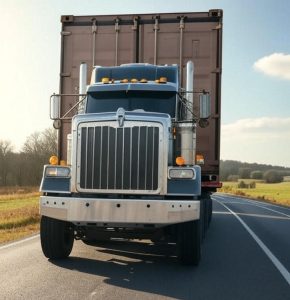
In this article, you’ll find out about oversized and overweight trucking loads and you’ll also learn about the regulations for tucking companies for carrying heavy loads.
What is Oversized and Overweight Truck Load?
In legal terms, an oversized load exceeds maximum legal limits for width, height, or length, while an overweight load exceeds maximum permissible weight. A load can be overweight, oversized, or both simultaneously.
Oversized Load
The National Network (NN) has travel lanes that are more the 12 feet wide. Oversized loads commonly exceed 8.5 feet in width. Although federal highway lanes are typically 12 feet wide, state limits vary. Height limits usually range from 13.5 to 14.5 feet, and length limits can reach approximately 75 feet. Moving an oversized load requires a special permit, and violations can result in substantial fines.
State regulations have also specified limit for length or height of the truck. However, the limits vary in states and there is no single legal limit. State limits generally range from 13.5 to 14.5 feet high, while the over-length limit is about 75 feet. Truck companies need to obtain a special permit for carrying oversized load. Not carrying a permit can result in stiff fines that are different in most states.

Regulations have also specified limits for weight of the load. An oversize load may also be overweight, but the opposite is not always true.
The lowest state maximum weight of a truck allowed by regulations is 80,000 pounds, and the maximum state allowable weight is 147,000 pounds in Florida per the FHA state by state index. Overweight loads exceed the standard 80,000-pound gross vehicle weight limit. Florida permits weights up to 147,000 pounds under special allowances. Weight limits also depend on axle configurations—such as 20,000 lbs maximum per single axle, or 34,000 lbs for tandem axles. Detailed limits vary by state.
Legal Requirements for Carrying Oversized Loads
Various types of cargo can be hauled in an overweight and oversized trucks. These include cranes, tractors, wind blades, bulldozers, prefabricated houses, and steel beams. The loads cannot be broken down into parts when transporting. This type of load in the legal context is called non-divisible load. To qualify for a load to be non-divisible, it must be such that dividing it may destroy the value of the load.
Apart from legal limits, there are time limits for carrying heavy loads. For example, in California heavy loads can be transported only between 9 am to 3 pm and 6 pm and 9 am. Trucking companies are also not allowed to transport oversized or overweight goods on holidays. You can find the exact time limit on your states Department of Transport (DoT) website.
Another legal requirement in some states is that oversized loads needs to be accompanied by escort cars. A pilot car is also required in case the load sizes is more than 20 feet wide. Every truck carrying heavy loads above the legal limit also must display banners that they are carrying oversized or overweight loads. Strobe land flashing lights are also required to warn drivers about the load.
What are the Fines for Carrying Oversized and Overweight Loads?

Trucking company needs to get a special permit from the state authority to carry oversized and overweight load. Without this permit, a company won’t be allowed to carry heavy loads. States have set different fines for transporting heavy goods that exceed the legal limit.
The fines for first offense can be up to $10,000. For multiple offense during the same year, the fines are doubled. The exact fine is based on how many pounds the load is overweight or oversized.
Accidents Due to Carrying Oversized/Overweight Loads
Every year a lot of truck accidents occur that involve heavy roads. The accidents generally occur due to many reasons. One of the main reasons is unbalanced loads. The unbalanced loads results in the weight of the truck to shift to the back. This makes it difficult for the truck driver to control the vehicle at high speeds. The center of gravity of a truck is high that increases the risk of rollovers. Moreover, an oversized load can also result in increased pressure on the tires. This can result in a tire blowout.
When traveling downhill, the load can increase the speed of the vehicle that can make it difficult to stop or slow down the truck.
Who Is Liable in Case of a Truck Accident Involving Heavy Loads?
The trucking company is in most cases liable for an accident associated with overweight and oversized vehicles. There are stiff penalties in most states for carrying overweight loads. Violations of the limits for oversized and undersized loads can be used as an evidence in a truck accident case. The trucking company will be held liable even if the driver was driving the vehicle responsibly if no permit was obtained for the oversized or overweight vehicle.
You should contact an experienced trucking injury lawyer after a collision with an oversized/overweight vehicle. The trucking company have the legal responsibility to ensure that properly trained drivers are hired who have experience in transporting large weights. An attorney will go through the permits and other documents to make sure that proper regulations were followed by the tricking company. This can make a big difference in winning and losing a truck accident involving trucks carrying overweight and oversized loads.
Make sure that you file a truck accident case within the time mentioned in your state’s statute of limitation. Generally, you can file a case within two years after a truck accident. In some states the statute of limitation allows up to four years of a gap after the accident for filing a claim.
Remember that determining liability is not easy with oversized and overweight loads. You must team up with an experienced truck accident attorney to increase the odds of a successful case outcome.
Disclaimer: Trucking laws vary by state and are subject to change over time. You should discuss any potential legal matter with a qualified attorney, this article is not legal advice nor is it intended to be used as information to rely upon to make legal decisions.
Image Credit: https://pixabay.com/users/clker-free-vector-images-3736/
